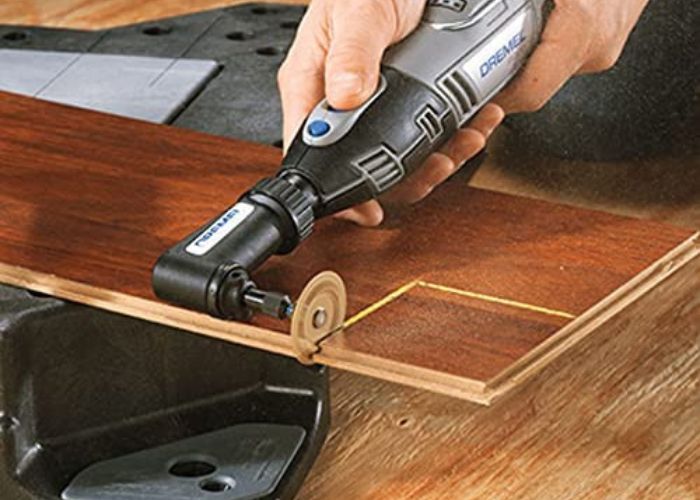You may not think of using a Dremel to cut wood, but this rotary tool offers an efficient way to work with wood.
Using the right tool is important to ensure precision in your woodworking projects.
So, if you are a DIYer getting started with your next big project, it’s a good idea to familiarize yourself with using a Dremel to ensure accuracy, efficiency, and safety.
A Dremel can be used on various materials, including wood, for trimming, grooving, and cutting perfect squares in wood. However, to use it effectively, following the necessary precautions and selecting the right accessories is important.
Can A Dremel Cut Wood?
Yes. A Dremel can cut through Plywood, hardwood, softwood, OSB, chipboard, laminates, MDF, and more. Some types of Dremel tools for cutting through wood are the Dremel mini saw #670 and the Dremel wood cutting wheel #544, among others. The Dremel multi-purpose cutting bit #565 is also great for cutting through wood.
First things first:
What is a Dremel Tool?
The Dremel tool is a versatile rotary tool that was originally invented by Albert J. Dremel in 1932. The tool has become incredibly popular for a wide range of applications due to its compact size and diverse functionality.
Over the years, Dremel has expanded its product line to include various models, each with specific features tailored for different tasks.
Overview of the Dremel Tool and Its Origins
The Dremel tool started as a simple rotary device, but its design has evolved significantly since its inception.
Originally, it was conceived as an alternative to large, stationary power tools. The main idea was to provide consumers with a hand-held, easy-to-operate tool that could perform multiple functions.
Dremel’s popularity skyrocketed because it filled a unique niche, offering a middle ground between manual hand tools and industrial equipment. (Find out other best brands of hand tools in our guide.)
General Functionalities of a Dremel
The functionalities of a Dremel tool are extensive and varied, thanks in large part to the myriad of attachments and accessories available. Here are some of the most common functions:
- Grinding: With the appropriate grinding stones, you can use the Dremel to sharpen blades or grind down metal, stone, and other materials.
- Sanding: Sanding drums can be attached to smooth out wood, remove paint, or finish edges.
- Cutting: By attaching cutting wheels or blades, you can use the Dremel for cutting through materials like metal, plastic, and, as we discussed earlier, wood.
- Drilling: While not a full replacement for a power drill, Dremel tools can handle light drilling tasks when fitted with the right drill bits.
- Carving/Engraving: With the appropriate bits, you can do intricate carvings on wood, metal, and even glass.
- Polishing: By using buffing wheels or polishing pads, you can polish metals and other materials to a high shine.
- Routing: With routing bits, you can hollow out areas in wood or create decorative edging.
- Cleaning: Wire brushes and other cleaning attachments allow you to remove rust and clean different types of surfaces.
Types of Dremels to Use to Cut Wood
Choosing the right Dremel is crucial when cutting wood, failing which you can ruin the wood and even hurt yourself. But with the right Dremel tools, you can achieve precise results. Wood insulates electricity well; therefore, using Dremel appliances is safe.
So, here are our top suggestions to help you make clean and sharp cuts on wood.
Dremel multi-purpose cutting kit #565
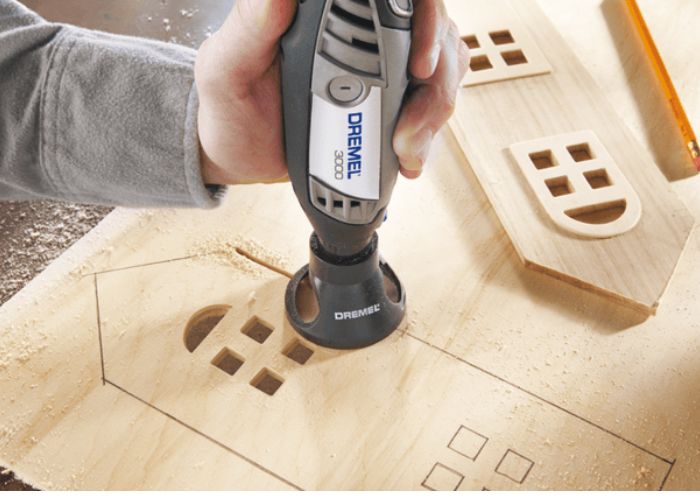
The 565 Dremel multi-purpose cutting kit delivers perfect results, especially with wood carving to create patterns or make circles.
Apart from wood, this kit can also work on many other materials, like vinyl siding, plastic, fiberglass, drywall, and laminate, making it an excellent investment. With the Dremel 565, you can cut, sharpen, polish, clean, engrave, carve, sand, grind, and rout wood.
You can adjust the depth of the cut to a maximum of ¾ inch (19 cm) depth, allowing efficient work with thicker pieces of wood.
However, one drawback of this tool is that it is quite slow and leads to more wastage, as it removes more wood.
Read also: Best woodworking bits for Dremel
Dremel mini saw #670
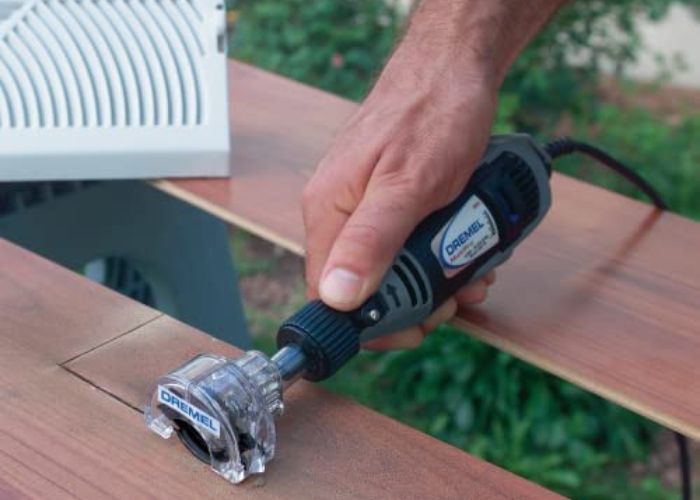
Mini Saw 670 is a Dremel attachment specifically designed to work on all sorts of wood. Thanks to the quick connect system, it is easy to attach it quickly to the Dremel.
Once attached, the Dremel tool made of high-speed steel transforms into a precision circular saw, capable of making clean and straight cuts. It is better than the traditional saw because it is easy to use, safe, precise, and fits tighter spaces.
The tool can make cuts that are ¼ inch in depth and is most effective for cutting long and thin pieces of wood, such as cutting thin wood plates, wood flooring, and laminate.
With this tool, you can also start making cuts in the middle of the wood, also known as plunge cuts.
Dremel wood cutting wheel #544
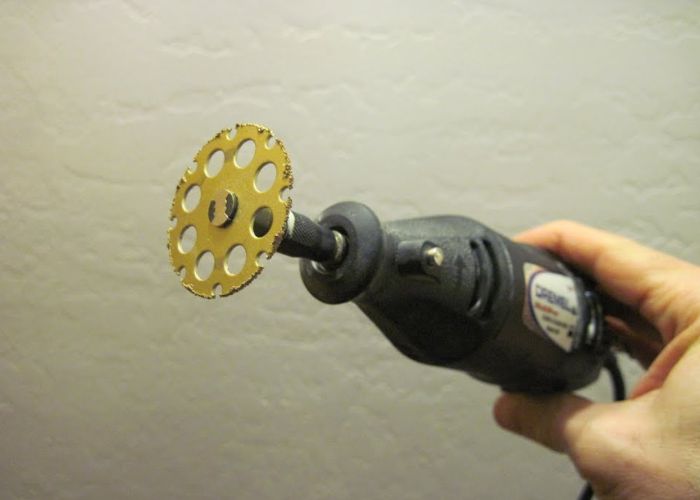
It is a comparatively new tool by the Dremel company designed to cut wood, plastic, laminate, and fibreglass but not metal. The Wood Cutting Wheel #544 has the patented EZ LockTM system, making accessory changes six times faster!
It looks like a complex table saw attachment blade with small interspersed teeth and has large chip removal areas that avoid clogging while making quick cuts.
The Dremel 544 can cut through ½ inch of wood quickly and easily with little effort.
Dremel plunge router #335
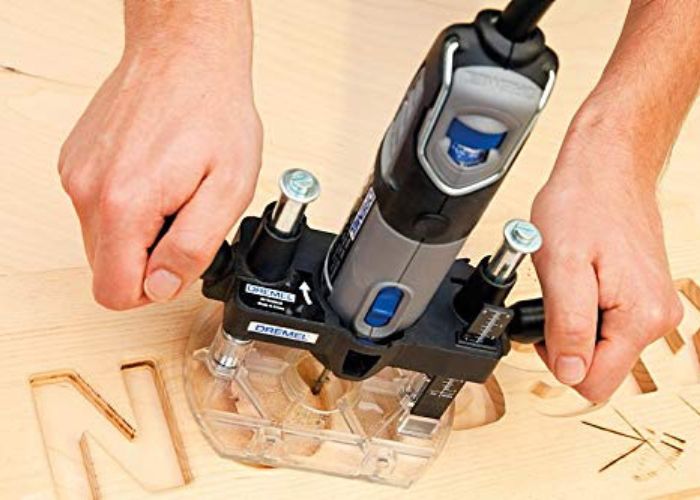
If you want to make woodworking designs, the Dremel Plunge Router 335 is the perfect router for the job. It makes accurate cuts in the wood and can be used for various routing projects, such as straight slots, inlay work, freehand routing, rout circles, and decorative edges.
The plunge lock-in handle helps with easy plunge locking, and the two depth stops facilitate quick release for adjusting routing depth. The tool also has a clear base that offers greater visibility, so you do not have to worry about damaging your material.
Besides allowing plunge cuts, it can help you make perfect circles and straight lines following the Dremel circle and edge guides. The tool even has integrated storage for a wrench and other bits.
Is a Dremel the Best Option to Cut Wood?
When you’re looking for efficient ways to cut wood, a Dremel doesn’t make the list of the best options. And even if it does, it is quite behind in the ranking.
However, it is still one of the most versatile wood-cutting tools that can be used to do various jobs. Dremel rotary tools are multifunctional and powerful, running at a very high number of rotations per minute, offering detailed and precise work.
They are lightweight tools that help with getting that accurate cut.
If you have a Dremel, it can effectively replace scroll saws, routers, drills, and grinders.
Here are some more reasons to use Dremel:
- The accessories are easy to assemble and disassemble. They are also user-friendly, even for novices. All products also come with instructions guiding customers on how to use them efficiently.
- Dremels can be used for sanding and polishing, with the finished products ensuring a natural gloss that makes them look more esthetic and expensive.
- Many different Dremel bits and accessories can help you make the cuts, designs, and shapes you want.
So, while Dremel may not be your go-to for wood cutting, you can still get great results if you know the specific attachments that must be used and how to operate them effectively.
Other Tools to Cut Wood That Are Preferred Over a Dremel
Many manual, electrical, or battery-operated tools are better for cutting wood than a Dremel. Some of the best tools are:
- Hand saw
- Router
- Tree loppers
- Pruning saw
- Bow saw
- Jigsaw
- Circular saw
- Band saw
- Japanese saw
- Chainsaw
- Plane
- Axe
- Chisel
How To Cut Wood Using A Dremel
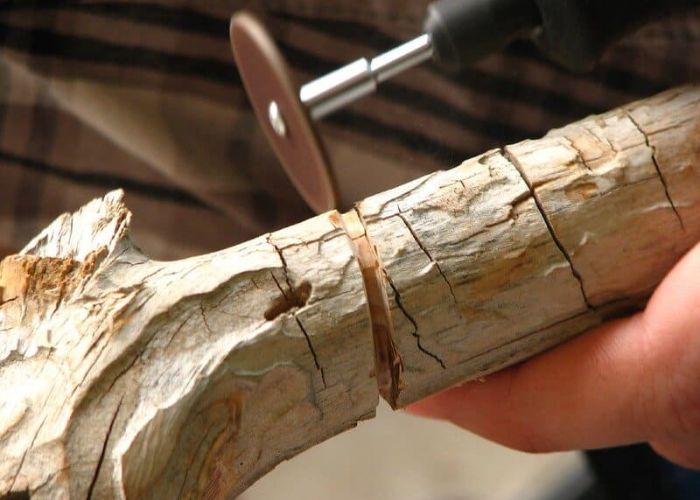
Since several Dremel bits can be used for cutting wood, there are also multiple ways to cut wood.
But before we get into how you can cut wood using a Dremel, let’s first look at the safety measures that must be taken:
- Wear safety glasses, a face mask, and gloves to prevent injuries.
- Make sure your accessory is fully inserted into the chuck or collet.
- Check and ensure there is no damage to the accessory.
- Make sure you are positioned away from the rotating accessory.
- Do not hold a small workpiece in your hand.
- Do not hold a power tool near flammable materials.
- Do not put down the power tool unless the rotating accessory has completely stopped.
- Do not use a Dremel when standing on a ladder or anywhere you can fall.
- Do not use it in an enclosed space, as the chances of small wood particles entering your eyes or you inhaling them is very high.
- You can use earplugs if the noise is loud and disturbing.
Supplies needed
The supplies you will need when cutting wood with a Dremel are:
- A Dremel rotary tool
- Dremel attachment or bit
- Wrench
- Pencil
- Clamp
- Workbench
- Wood
- Tape measure (See our review on the best tape measure for woodworkers.)
Step-By-Step Process of Cutting Wood
Step 1: Prep your workspace
Once you have all the supplies and have put on the safety gear, prepare your work area and ensure it is clear and spacious.
Working with wood invariably involves a lot of debris flying around, so remove things from around the work table and clear the space. It will also help you move freely and avoid accidents.
Debris can also cause breathing issues, so your workspace should be well-ventilated.
Once you have cleared your workspace, secure your wood so it does not move. The Dremel is a powerful tool that exerts much force on the wood, moving it from its original place.
This may make it more difficult to handle, increasing the chances of mistakes and cause accidents. To avoid this, use a workbench and secure the wood with the help of clamps.
Step 2: Mark the wood
Mark the area on the wood to be cut with a pencil, stencil, or marker. It may seem like a trivial thing but markers are important for accurate and precise cuts. They help you guide your tool through the wood, avoiding mistakes and potential damage.
For best results and to avoid uneven cuts, mark along the wood grain, because Dremel works best when used along the direction of the grain.
Step 3: Choose the right accessory
Determine the correct accessory suitable for the task at hand. You will also need to consider the size and thickness of your wood and what kind of cut you want to make.
Once you’ve chosen the accessory, secure it on the Dremel tool properly. This will involve removing the collar, firmly attaching the accessory to the hole at the end, and tightening the collar nut to attach it firmly.
If you already have a Dremel bit, replace it with another. To do so, press the downward button on the tool shaft and turn in the collet. This will loosen the existing bit. Remove it and replace it with the bit you want.
Make sure the Dremel is unplugged during this step.
Step 4: Make your cut
If you are cutting wood or using a Dremel for the first time, follow video tutorials before handling the tool. You have to master positioning the tool before cutting.
Accessories like cutting wheels have to be perpendicular to the wood. If you have to remove large chunks of wood, use saw attachments first.
Adjust the speed and hold the Dremel with both hands firmly before moving it toward the wood grain. This is done to avoid skipping some areas.
Do not apply too much or too little pressure. It’s a good idea to experiment on wood scraps first to determine how much pressure you apply to make precise cuts.
You will also need to consider the type of wood here, as hardwood will require more pressure and speed than softwood. A good example is in balsa wood cutting.
Work on the cut till you get the desired depth.
If you want to cut wood at 45 degree angle, read our article to learn the skills.
Step 5: Finishing touches
Once you have completed cutting, it is time to add the finishing touches. Remove the current attachment and add a grinding bit. Grinding will make the cut surface smoother, but do not exert too much pressure as that will cause damage. You can also sand the edges to make them smoother and remove rough spots.
While cutting, you should avoid touching the cut area while cutting as it may be a bit hot and have sharp protrusions. Do not touch the work area either, as it will have sharp objects.
Clean the area often to avoid sawdust buildup. Sawdust compromises visibility and interferes with accurately assessing the cut. If the workspace is unclear, you may miss the markings and end up with an overcut or undercut wood, eventually leading to more work.
Best Dremel Attachments for Cutting Wood
The best Dremel for a wood job will depend on the type of cut you want to make, the thickness of the wood, and how accurate you want the cuts to be.
Different types of Dremel accessories perform different functions, so it’s a good idea to research them or consult an expert to help you with the correct attachment.
For example, if you want to make long, thin cuts, a mini saw 670 will be your best bet. But if you want to make patterns, routing, or plunge cuts in the middle of the wood, then the plunge router 335 is an ideal pick.
Basic Wood Cutting Techniques with Dremel
Using a Dremel tool for wood cutting offers a unique blend of precision and versatility. However, to make the most out of your Dremel, you should understand some basic wood cutting techniques. Below, we’ll cover how to make straight cuts, curved cuts, and intricate designs and carvings.
Straight Cuts
- Choosing the Right Bit: For straight cuts, you’ll likely want to use a straight-edge cutting guide and a cutting wheel or straight bit designed for wood.
- Setting Up: Secure the wood piece you’ll be cutting onto a stable surface. Make sure the Dremel is set to an appropriate speed, usually a medium-to-high setting, but refer to your user guide for specifics.
- Pilot Hole: It’s often a good idea to drill a pilot hole at the starting point of your cut. This will help guide your Dremel tool and make your job easier.
- Cutting: Turn on the Dremel and lower the bit gently onto the wood at the starting point. Move the tool along the cutting line steadily but not too fast, letting the speed of the rotary action do the work.
- Finishing: Once the cut is complete, switch off the Dremel and inspect the cut to ensure it’s clean. You may need to sand down rough edges.
Curved Cuts
- Bit Selection: For curved cuts, a spiral cutting bit or a regular cutting wheel can work well, depending on the radius of the curve.
- Marking the Path: Outline the curve you want to cut with a pencil or chalk for guidance.
- Guided Cuts: Unlike straight cuts, you may need to freehand curved cuts, although some Dremel models have a circle cutter or edge guide for this purpose.
- Cutting Technique: Initiate the cut at the starting point, then carefully guide the tool along the marked path, maintaining a steady speed. It’s better to make multiple shallow passes for more control.
- Final Touch: You may need to go back and sand the curve for smoothness.
Intricate Designs and Carving
- Bit Selection: For intricate work, specialized carving bits are usually necessary. These can range from fine point tips to rounded or V-shaped bits.
- Design Outline: Sketch the design onto the wood. Alternatively, you can also use a stencil.
- Speed and Pressure: Use a slower speed setting for greater control and reduce pressure as you work on finer details.
- Carving Technique: Start carving from the outline and work your way towards the center. Always carve away from yourself for safety.
- Layering: For 3D designs, you might need to carve in layers, starting shallow and then going deeper for more depth and texture.
- Finishing: Once the carving is done, sand it lightly to remove any burrs or rough spots.
Read More: Screw Into Wood Without a Power Drill
Common Mistakes to Avoid
Avoiding common mistakes when using a Dremel tool for wood cutting can save both time and resources, not to mention ensure your safety. Below are some frequent pitfalls along with recommendations on how to sidestep them:
Wrong Blade Choice
- Mismatched Materials: Using a blade not designed for wood can result in poor cuts and can even damage your Dremel tool.
- Using a Dull Blade: Blades lose their sharpness over time. Using a dull blade can lead to uneven cuts and increased safety risks.
- Solution: Always consult the manufacturer’s guidelines to choose the correct blade for your specific wood cutting needs. Keep an array of blades on hand for different types of cuts and regularly check for wear and tear.
Incorrect Speed Settings
- Too Fast: Using a speed setting that’s too high can cause the blade to overheat or even break. It can also result in burn marks on the wood.
- Too Slow: A speed that’s too slow can result in jagged, uneven cuts and may even cause the tool to get stuck in the material.
- Solution: Start with a medium speed and adjust as needed based on your project’s requirements and your tool’s performance. Refer to your Dremel’s user manual for specific speed recommendations for wood cutting.
Failing to Secure the Wood Properly
- Movement During Cutting: If the wood is not securely fastened, it can move during cutting, leading to imprecise and potentially dangerous situations.
- Damaging the Work Surface: Failing to secure the wood can result in a bad cut and damage to the work surface underneath.
- Solution: Use clamps or a vise to hold the piece of wood securely. Make sure the clamping mechanism itself is stable and will not move during cutting. Always double-check your setup before you begin.
Here is a guide on the places that will cut wood for you, free and paid.
FAQs
What Dremel piece do I use to cut wood?
Dremel pieces like wheels, routers, and saws are useful for cutting wood.
Can I cut a 2×4 with a dremel?
Yes. With the right attachment, like the Dremel ultra saw, you can cut a 2×4 piece of wood.
Does Dremel make a wood cutting blade?
Dremel does make wood-cutting blades. Some examples include the Dremel MM480 Oscillating blade, the Dremel MS52 wood-cutting saw blade, and the EZ544 wood-cutting wheel.
How to cut wood shapes with a Dremel?
You need to use the right attachments to cut wood shapes with a Dremel. For example, if you want to make plunge cuts, use a mini saw 670 or plunge router 335.
How to cut a circle in wood with a Dremel?
The right accessory for making a circle with a Dremel is a Dremel multipurpose cutting kit 565 and plunge router 335. Drill a hole in the center, plunge the accessory, and cut.
Interesting read: Can a Dremel cut metal?
Final Thoughts
The Dremel is a highly versatile and efficient tool that can be very useful for cutting wood. However, to use it effectively, you also need to know about its various attachments and which of them would be best for your project.
We hope this guide helps you use a Dremel efficiently to ensure precise and clean work on your next woodworking project!

